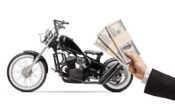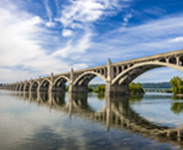
Home > Motorcycle Community > Tips for Motorcycle Riders > A Guide to Motorcycle Helmets
A Guide to Motorcycle Helmets
Motorcycle helmets are the most effective gear for saving motorcyclists’ lives. They can significantly reduce your risk of injury or death in a crash. However, not all helmets are made the same or have the same level of protection. You need to choose a helmet that will protect your head and look good enough to make you want to wear it. This comprehensive helmet buying guide will equip you with the knowledge needed to choose the perfect helmet for your riding adventures.
Types of Motorcycle Helmets
There are a variety of motorcycle helmet styles to suit different riding styles and needs.
- Full-face: The full-face helmet covers your entire head and face, providing maximum protection on the road. This style was traditionally most popular with sport bike riders. However, more cruiser-style riders are embracing these helmets for their protection abilities.
- Open-face: The open-face (or three-quarter) option shields the sides, top, and back of your head while leaving your face uncovered. The increased comfort means sacrificed protection.
- Modular: The modular helmet combines full-face protection with a flip-up front for convenience.
- Half helmet: The half helmet (also known as a “shorty”) provides minimal coverage and is considered ineffective at protecting your head and face.
- Off-road: Off-road helmets are designed for wearing on dirt and motocross bikes. They provide extra chin and mouth protection with a more rugged construction.
- Dual-sport: Dual sport helmets cater to both on and off-road riding, offering a blend of features from different helmet types.
- Enduro: Finally, helmets labeled Enduro, ADV, hybrid, or crossover are crafted for versatile adventures, incorporating elements from various styles to suit diverse riding conditions.
Motorcycle Helmet Construction
At its core, a helmet consists of three main layers: an outer hard shell, a middle impact shock absorber, and the innermost comfort layer for the rider. The middle layer is often made of EPS (Expanded Polystyrene).
Higher-end helmets usually have an exceptionally tough outer shell, providing top-notch protection. The middle layer will have multiple layers of various densities to provide better cushioning ability. In contrast, cheaper helmets tend to have a single layer of uniform density.
The materials used also vary significantly. Cheaper helmets typically use thermoplastic or thermoset resin for the outer shell, which can be heavier and bulkier. High-end helmets use stronger and lighter-weight materials like carbon fiber, fiberglass, or aramids. These premium materials contribute to better durability and enhanced safety features.
Motorcycle Helmet Safety Testing
Since the purpose of buying and wearing a helmet is to protect your head, you should look for one that can verify its ability to do this. You’ll find several testing certifications, and some are better than others.
DOT
In North America, the Department of Transportation (DOT) sets the federally mandated standard for helmets, but interestingly, the DOT doesn’t regularly conduct the actual testing. Instead, helmet manufacturers perform the testing themselves, a process known as self-administration. This means that while helmets must meet certain criteria set by DOT, the testing to ensure compliance is done by the companies producing the helmets.
ECE
In Europe, helmets must meet stringent safety standards set by ECE 22.05. This regulation ensures thorough testing, including shock absorption, penetration, impact, rotational crash simulations, and accessory testing. These rigorous evaluations guarantee helmets meet high safety benchmarks before hitting the market.
SNELL
The Snell Memorial Foundation, founded in 1957, introduced comprehensive helmet testing standards in 1985 to ensure riders’ safety. Operating from its test facility in Sacramento, GA, Snell takes a unique evaluation approach. Rather than testing the entire helmet, they focus their impact testing on roughly the mid-ear level and up. During the examination, helmets are struck against various surfaces to simulate real-world crashes.
BSI
The British Standards Institute (BSI) sets helmet safety standards comparable to SNELL, focusing on rigorous testing. BSI conducts tests on shock absorption, measuring the helmet’s ability to absorb impact energy effectively. Additionally, they evaluate penetration resistance, ensuring the helmet can withstand external forces. Moreover, if included, BSI scrutinizes harness retention and chinstrap properties to ensure optimal safety standards for riders.
How to Buy a Motorcycle Helmet
Understanding the key factors and nuances involved in the selection process ensures comfort and safety on the road. You need to consider size, shape, features, and price.
How to Find the Right Helmet Size
Finding the perfect helmet size is crucial for both comfort and safety. It should fit snugly and not move around on your head while riding. If it’s too loose, you might experience excessive wind noise. If it’s too tight, it can create uncomfortable pressure points.
To measure your head size accurately, use a tape measure and wrap it around your head, just above your eyebrows and ears, and around the widest part of the back of your head. Once you have this measurement, compare it to the size charts provided by different helmet manufacturers. Sizing is not universal, so you could easily be a medium in one brand and small or large in another. Your size could also vary with different helmet designs within the same brand. Use your head measurement to find a size as a starting point.
Additionally, consider your head shape; there are three primary shapes—round oval, intermediate oval, and long oval—with the intermediate oval being the most common. Hold your phone directly over your head and take a picture of the top of your head to get an idea of your head shape. Then, look at the general shape of your head. Trying on helmets and paying attention to how they fit your specific head shape will ensure you find the right size and shape that offers both comfort and security while you ride. If the helmet feels really tight at the front and back of your head, you may need more of an oval shape. If the helmet feels tight on the sides, you may need more of a round shape.
Another thing to keep in mind is that helmets often come in different shell sizes to fit different head sizes within the same model. This reduces manufacturing costs. However, the fewer the shell sizes, the greater the risk of feeling like a bobblehead. Look for a helmet with a higher shell number to have a closer-to-the-head fit.
Choose a Motorcycle Helmet Brand
Some brands consistently adhere to a specific head shape across their product lineup, while others might offer different helmet forms within their various models, which can be a bit perplexing. It’s helpful to research and try on different models from multiple brands. Here is a non-exhaustive list of common brands to help you get started.
- AGV-intermediate oval
- Arai- intermediate oval, long oval
- Bell- round
- Biltwell- round
- HJC- round
- LS2- long oval
- Shark- intermediate oval
- Shoei- intermediate oval
Choose a Helmet Color and Design
Selecting the color and design of your helmet involves several considerations. Opting for a color that enhances visibility on the road is a smart choice, as it improves the ability of other drivers to see you. Some riders prefer plain colors for a classic, understated look, while others prefer bold designs that stand out. Additionally, coordinating your helmet’s color and design with the rest of your riding gear can create a cohesive and stylish look. Ultimately, the choice comes down to personal preference, balancing visibility and how you want to express yourself while riding safely.
Get the Right Fit
When trying a helmet on, wear it for 10 to 15 minutes to assess its comfort over time. A helmet that feels comfortable when you initially put it on can develop hot spots the longer you wear it. This is a problem, as the discomfort will distract you while riding. Position it so that the top of the viewport or visor sits just above your eyebrows. Feel for even pressure around your head; any ‘hotspots’ or areas where you feel pain or discomfort indicate an improper fit. Your helmet should feel snug but not excessively tight. Finding a balance where it feels secure without causing discomfort is important.
Helmet Features
Ventilation is a must to keep things cool by regulating airflow. Then, interchangeable cheek pads help you get a custom fit around the face. Removable liners make maintenance a breeze. Changeable visors adapt to different light conditions or can change the look of your helmet. If visibility is a concern, an anti-fog visor might be your go-to. Some helmets come with ear speaker compartments, perfect for music or communication systems. Don’t forget about aerodynamics and wind channels; they help reduce wind noise and keep you steady at higher speeds. Lastly, emergency response quick-release tabs ensure swift helmet removal by responders in case of an accident, prioritizing prompt medical attention.
Motorcycle Helmet Pricing
When it comes to motorcycle helmet pricing, there are options to suit various budgets and preferences. Entry-level brands like HJC, Scorpion, and LS2 offer affordable helmets without compromising quality. These helmets typically cost $200 or less. Moving up, higher-grade options from brands like Shoei, AGV, and Icon provide a balance between quality, features, and cost. These helmets are between $300 and $600. For those seeking top-tier helmets with premium features, high-end brands such as Arai, Schuberth, and X-Lite (by Nolan Group) offer cutting-edge technology and superior craftsmanship, often commanding higher price points. These helmets start about $600-$700 but can easily be several thousand dollars. Each category caters to different needs, ensuring riders can find a helmet that fits their budget while meeting their safety and style requirements.
Motorcycle Helmet Laws
Motorcycle helmet laws vary significantly from state to state. For instance, in New Jersey, all riders must wear a helmet while on the road. It’s essential to be aware of and comply with the specific helmet laws in the state where you’re riding to ensure you’re meeting the necessary safety regulations and protecting yourself adequately.
Helmet Accessories
When it comes to accessorizing your helmet, the options are pretty diverse. Consider communicators for chatting with fellow riders while on the go. An action camera is a cool addition if you want to capture those thrilling rides and share your adventures. And for those who love a touch of personal style, decorative add-ons like cat ears, devil horns, or even ponytails are available to spice up your helmet. While these accessories don’t directly impact safety, they sure add a fun and personalized touch to your riding gear.
When to Replace a Motorcycle Helmet
Typically, helmets should be replaced every 3 to 5 years, even if they seem undamaged. The inner foam shell and lining deteriorate over time, affecting their protective capabilities. Additionally, if your helmet has been in an accident, getting a new one is essential, as its integrity might have been compromised. Even if it has endured minor mishaps like drops or bangs, it’s safer to replace it. Exposure to the elements, whether left outside or in a garage, can also expedite the materials’ degradation.
DON’T BUY USED
Steer clear of used helmets when shopping. When you buy a used helmet, there’s uncertainty about its history. You can’t be sure how it was treated or how many times it might have taken a tumble. Plus, helmets mold to the shape of the original owner’s head over time. This custom-fit might not be the right match for your own head shape, compromising the helmet’s ability to protect you effectively.
Protect Your Head With This Helmet Buying Guide
Riding a motorcycle can be exhilarating, but safety should always come first. Motorcycle helmets aren’t just accessories—they’re essential safeguards that protect your head and face in case of an accident. From full-face shields to open-face options, the right helmet can make a significant difference in minimizing injuries and saving lives. However, safety extends beyond just wearing a helmet; having motorcycle insurance is equally crucial. It ensures financial protection in case of unforeseen events on the road. Don’t compromise on safety or risk the unexpected; take the next step towards comprehensive protection by securing a motorcycle insurance quote today. Prioritizing safety on the road isn’t just a choice—it’s a responsibility.





